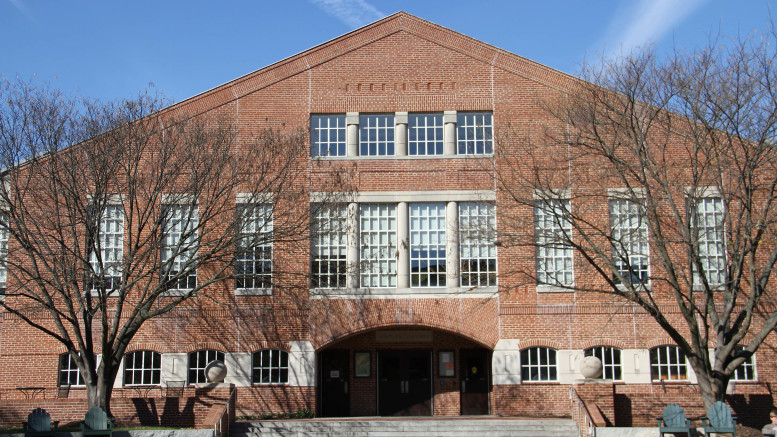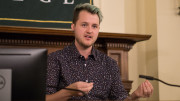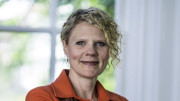In an effort to increase communication between students and administration beyond the “Ask McDaniel Anything” forums, the President’s Council met with a group of students on Oct. 29 to answer questions the students deemed important.
The President’s Council is composed of President Roger Casey, Executive Vice President and Provost Julia Jasken, Vice President for Finance and Administration Tom Phizacklea, Vice President for Enrollment Janelle Holmboe, and Vice President for Institutional Advancement Vicky Shaffer. The Council asked Dean of Students Liz Towle to assemble a group of student leaders who would be interested in participating in the discussion.
Ahead of the meeting, Towle met with the selected students on Oct. 24 to brainstorm a list of questions to present to the Council. The students in attendance were Aaron White, Ravi Patel, Lucero Espinal, Jake Fine, and the author of this article.
At the Oct. 24 brainstorming session, students expressed an interest in learning about updates regarding the situation in the Financial Aid office, why student workers were handling financial aid documents over the summer without signing a non-disclosure agreement, why fewer students were awarded federal work study this year, why Campus Safety officers have been entering residences unannounced, how Casey proposes to house another large incoming class next year, how Institutional Advancement communicates campus needs to potential alumni donors, why food quality has declined in the dining hall since the start of the semester, where students can use meal exchanges, and how the Decker College Center renovations will continue to affect access to the building.
Towle specified that she could address some of the proposed topics, which would narrow the list presented to the Council. On Oct. 26, she sent a campus-wide email detailing current entrances to access Decker and upcoming changes to these access points as construction expands. On Nov. 3, Towle emailed the campus community with information about the newly extended hours in Caseys’ Corner and the newly offered meal exchange option.
Towle also followed up with the student leaders to share that she had contacted Holmboe with concerns regarding student worker access to private student information in the Admissions and Financial Aid offices. Holmboe confirmed that the practice of student workers accessing private information was being revised and student workers would immediately begin signing confidentiality agreements. Finally, Towle told the student leaders who brought up concerns with Campus Safety they’ve heard from others to encourage the affected students to reach out to her directly.
On Oct. 29, the President’s Council allotted the group of student leaders a 30-minute meeting. The discussion ran for a whole hour. Below is an overview of the topics covered during the meeting.
State of the Financial Aid office
Holmboe explained that the department has been understaffed for over a year and has experienced a lot of turnover.
“As of now, we have one staff member who has been at the department for more than a year. We have one who has been here for about six months, one who has been here around three months, and we’re in the process of hiring the remaining positions,” said Holmboe.
Once fully staffed, the office will have seven employees, as opposed to the previous staff of six. They just hired one new staff member with five years of financial aid experience and are in the process of checking references for a second potential hire. They are currently rewriting the position description for the final position they’re looking to fill. At the moment, the office is being run by interim staff.
Holmboe also addressed concerns regarding the delay in awarding students financial aid for the Fall 2019 semester.
“We have spent probably the past two months really digging in to try and get ourselves caught up,” Holmboe said.
According to Holmboe, there are about 300 students with balances over a thousand dollars. For at least a hundred of those students, financial aid processing has been completed, but the students have yet to pay their fall tuition. These students will experience a registration hold and will be unable to register for spring classes until they have paid for this semester.
There are about another 20 students who have not yet filed a FAFSA, which means the Financial Aid office cannot assess them for need-based aid. There are about another 25 who are in the verification process and have yet to either submit a necessary document or present a parent signature for the office to proceed with verification.
“So there’s about a hundred or so that are in some state of they’re waiting on Financial Aid,” Holmboe said. “We’re working closely with the Bursar to release holds from students from whom we know financial aid will cover their balance once it’s applied.”
The Financial Aid and Bursar offices are also planning to hold joint office hours to speed up this process and avoid having to “shuttle students back and forth” between the two offices. For the future, Holmboe wants to implement a case-load model where students are broken up by alphabet and assigned to a specific Financial Aid counselor that they would work with for all four years.
“What I’m seeing now is that students have to repeat sometimes deeply painful and very personal stories every single time they have to come into that office because they might see someone different,” Holmboe said. “And so this would allow people to have one person [and they can] develop a relationship with their Financial Aid professional.”
Holmboe also addressed concerns regarding federal work study approval. She believes the new employees in the office were overly conservative in how they initially awarded the work study, but the office is now working to award additional work study to students for the spring semester.
College size and housing
Casey explained that no one anticipated this first-year class to be as large as it is.
“When we look at our historical yield rates and our anticipated budget numbers for this year’s class, we went into this process anticipating and budgeting for a class of 430 or so,” Casey said.
According to Casey, application numbers went through the roof this year, and then students didn’t “melt” away throughout that process. In May or June, the College realized there would be a housing problem, so they reached out to the Best Western as an alternative plan.
Casey also explained that temporary triples and converted rooms have been used multiple times in history, with a little over 10 years ago being the last time. Converting rooms to triples and quads adds 44 more beds, for which Residence Life tried to find volunteers by offering a financial discount. They ended up finding more volunteers than necessary, so no one was placed in a triple or quad who didn’t want to, Casey said. The College also converted Harrison House and acquired a few properties on Pennsylvania Avenue that they already had their eyes on for awhile.
“We wound up in a pretty tight situation both time-wise and numbers-wise, but we wound up not having to put anybody in the Best Western, which was in some ways a miracle,” Casey said.
Much of the most recent Board meeting focused on housing for the future, he added. The graduating class of 2020 is a small class, so there will be more housing needs next year.
“We looked at an entire host of choices [at the Board meeting]. Everything from acquisition of properties and conversion of existing facilities to building of new residence halls,” Casey said. “The Board is determining right now which of those routes we go.”
Casey shared that the administration has strategies for a normal-sized class and is currently developing strategies for a class that would be as large as the one brought in this year. They are budgeting for a class of roughly 500 students.
“That’s where we’ve wanted to be for years. This is not like some new thing. We just haven’t brought in that number,” he said. “When we looked at our 5-year model from 5 years ago, it was to be building classes of roughly this size.”
Continuing to build classes of this size would create a student body of roughly 1800 students. Casey cited strategic plans adopted for the College back in 2001 that specified that the student body should be 1800 students.
“This is not some new concept or something we’ve picked out,” Casey said. “So, when I said I’d love to have more classes of this size, yes! The more students that we have (within reason), this is where we would love to be.”
Casey explained that the added revenue from a larger class size would allow the College to use tuition dollars to resolve financial aid issues, keep tuition down, increase staffing, and add compensation packages that would be attractive to staff and keep them from leaving.
“Student bodies of this size actually help everybody, I think, in the long run, provided we have the resources and ability to plan,” Casey said.
Institutional advancement
Shaffer was not in attendance at the meeting, so Casey addressed questions about institutional advancement. He explained that the College approaches donors with institutional priorities, as opposed to alumni approaching the College with a proposed project.
“Since at least 12 years ago, the number one most requested institutional priority from students has been the expansion and renovation of Decker. When I was a candidate for this job, all I heard was ‘fix Decker, fix Decker,’” Casey said. “When I hear students now say ‘we’ve never talked about this being a need,’ I think of words that I could say, but I don’t say those because all I’ve heard for 10 years is ‘do something about this building. We need a better student center.’”
An alumni couple donated $5 million to the Decker renovations, which is half the cost of the project. According to Casey, $8 million were raised “before we even put the shovel in the ground.” Now, the College is trying to raise the last $2 million. Casey mentioned that he just solicited $25 thousand for the project the day before the meeting with the student leaders.
“Ultimately our goal is when we pay all the bills and the place opens next August, we’ll have $11 million so it’s completely paid for,” he said. “Under no circumstances will this money for that facility come from tuition operating dollars. It’s all funded by gifts.”
Student leaders then followed up with a question regarding priority assessment. Casey cited student satisfaction surveys as the main way the College gathers information. Four years ago, the College evaluated these surveys to understand whether students wanted air conditioning or something else. According to Casey, it costs about $5 million per residence hall to install air conditioning. And yet air conditioning “really didn’t pop up there” in the surveys.
“One of the things that I think happens sometimes is students say ‘oh, you didn’t ask me.’ Well, that might be true. I didn’t ask you. Because we’re making these decisions 7, 8, 10, 12, 15 years in length,” Casey said. “It’s very feasible that the intensive work that you have done on your next major project was actually derived completely from analysis of student comments who don’t even go here anymore. So I think sometimes, that’s where the sense of disconnect comes.”
Casey specified that the student center “has been in the pipeline” at least since 1999.
Student representation
Student leaders then asked whether there is an effort to communicate these plans to incoming classes. They felt that it was rare that the student body receives an official communiqué informing students of long-term plans.
“I don’t mean to throw [SGA Vice President] Aaron and [SGA President] Amara under the bus on this, but the reality is you have SGA representation on the Board of Trustees and we didn’t have SGA representation sitting at this past Board of Trustees meeting. We had three full decades of Board meetings,” Casey responded. “There are colleges across this country in which student bodies and faculty protest outside because they aren’t allowed to get into a Trustees meeting. We have open Trustee process where all these decisions are talked about and we didn’t have anybody there. And that, to me, is the obvious and logical pipeline that you want to plug people into.”
Casey suggested electing representatives that would attend the Board of Trustees meetings and then report back to the student body.
Jasken added that Towle, as adviser to the SGA, wants to shift the focus of the group from planning social events to being tied in to the center of decision-making at the College.
“We need to find a mechanism by which the students are voting on representatives that they want to be their voice because we can’t meet with every student,” Jasken said. “It’s very important for us to have your feedback as well. So we need that relationship with our SGA representatives as well.”
Casey reiterated the importance of being present at the Board of Trustees meetings.
“It is shocking to me that, over the years, our visitors to the Board have not with more frequency taken that responsibility on and been there,” he said. “Because every single major decision this College has is made at that table.”
Casey explained that, in previous years, random students sat in on the Board before the administration decided to tie in SGA representatives as a more structured system for student representation. The student leaders asked whether that can be expanded beyond SGA representation, to which Casey stressed the importance of an elected, rather than appointed, representative.
“I would also say: read the emails. We send out many times very extensive descriptions of ‘here’s a project going on, here’s the construction going on, and here’s the process that’s going to happen and here’s where it’s going to go’ and nobody reads them,” Casey added. “I don’t know how you know anything if you don’t read it. To say, ‘nobody’s told me anything’ because you haven’t read anything is just not much of an excuse in my book.”
The meeting concluded with a discussion regarding the frequency of future meetings.
“If we can have that half hour regularly with this group and then have additional kinds of communication that happens outside of that, the half hour doesn’t feel like this is the one opportunity to do this,” Jasken said.
Then, on Nov. 5, Towle met with the student leaders once more to follow up on the President’s Council meeting and plan for future ways to facilitate open communication. Patel, Espinal, and the author of this article were present at this meeting. In addition, Annalise Bell joined the group and was invited to attend future meetings.
Towle hopes to establish a group of 8-10 students to meet periodically and share information both ways. She wants the student leaders to represent “slivers of different student life” and is curious about what’s happening on campus. Logistics regarding the frequency of meetings and how the discussed topics will be distributed to the rest of the student body are still being finalized.




